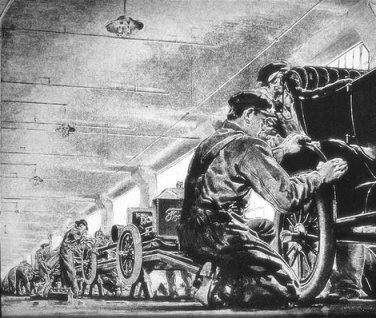
Image courtesy of American Memory Collection,
Library of Congress
INDUSTRIAL
REVOLUTION QUIZ: U.S. STUDIES

Image courtesy of American Memory Collection,
Library of Congress
|
_C_1)
This term refers to the process of becoming a city-dwelling nation,
away from rural living. _I_2) This 1862 law allowed the two railroad
companies to begin building the transcontinental RR. _K_3) This invention, developed by Samuel Morse,
grew along side the expanding railroad industry. _H_4) After making a fortune in the shipping business,
he became owner of the New York Central RR _N_5)
He was granted over 1000 patents including the phonograph, stock ticker,
and indoor incandescent lamp. _D_6)
He improved the generator that allowed electricity to be shipped long
distances, but he is best known for the railroad air brake. _B_7) This state contains huge coal deposits and
was the site of the first oil well drilled in 1859. _L_8)
This end of this event gave foreign investors confidence to invest
in US business. It also allowed the railroads to expand and allow for increased
production. _M_9)
This term involves helping the poor through the donation of huge
sums of money and the creation of organizations
set up to education or feed the poor. _F_10) He built the first trust by
buying out the competition in the oil industry and refineries. _O_11) This method of steel production resulted in the improvement in steel quality that allowed for greater railroad development In the mid-1860s. _G_13) This law stated that ďall business combinations in restraint of
tradeĒ (monopolies) are illegal.
_P_16)
He developed the assembly line from its early beginnings in Samuel
Slaterís textile factory of the 1790s.
|
A) Interlocking
Directorate
B) Pennsylvania C) Urbanization D) George Westinghouse E) Social Darwinism F) J.D. Rockefeller H) Cornelius Vanderbilt I) Pacific Railway Act J) J.P. Morgan K) Telegraph L) The Civil War M) Philanthropy N) Thomas A. Edison O) Bessemer Process P) Henry Ford
|
Back to Industrial Revolution Quiz